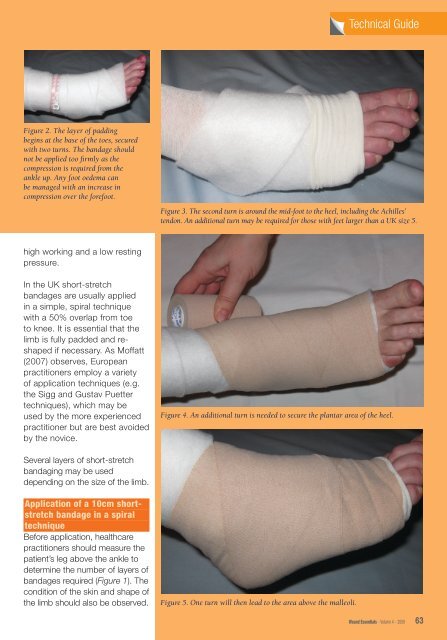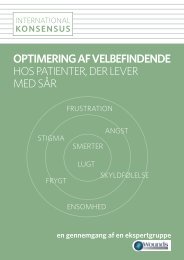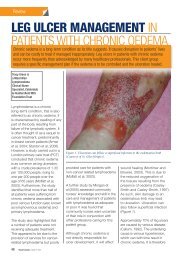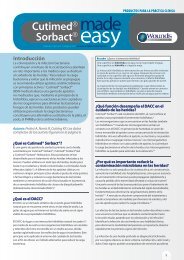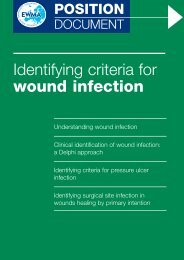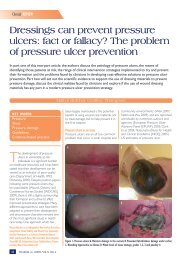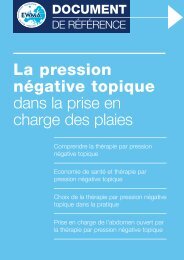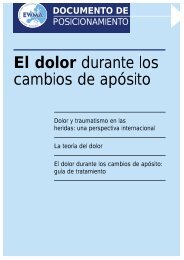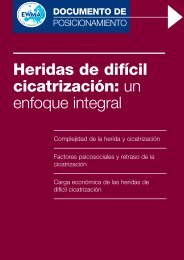Technical GuideFigure 2. The layer of paddingbegins at the base of the toes, securedwith two turns. The bandage shouldnot be applied too firmly as thecompression is required from theankle up. Any foot oedema canbe managed with an increase incompression over the forefoot.Figure 3. The second turn is around the mid-foot to the heel, including the Achilles’tendon. An additional turn may be required for those with feet larger than a <strong>UK</strong> size 5.high working and a low restingpressure.In the <strong>UK</strong> short-stretchbandages are usually appliedin a simple, spiral techniquewith a 50% overlap from toeto knee. It is essential that thelimb is fully padded and reshapedif necessary. As Moffatt(2007) observes, Europeanpractitioners employ a varietyof application techniques (e.g.the Sigg and Gustav Puettertechniques), which may beused by the more experiencedpractitioner but are best avoidedby the novice.Figure 4. An additional turn is needed to secure the plantar area of the heel.Several layers of short-stretchbandaging may be useddepending on the size of the limb.Application of a 10cm shortstretchbandage in a spiraltechniqueBefore application, healthcarepractitioners should measure thepatient’s leg above the ankle todetermine the number of layers ofbandages required (Figure 1). Thecondition of the skin and shape ofthe limb should also be observed.Figure 5. One turn will then lead to the area above the malleoli.Wound Essentials • Volume 4 • 2009 63
1390 142 BOSCOLO Andrea Via Verona,5 - 30015 Sottomarina (Ve) / Chioggia aboscolo@alice.it 0039 328/73565411542 143 BOTTARO Marco marco.bottaro10@gmail.com 0039 329/7152553978 144 BOTTINI Simone Via Bellincione,10 - 20134 Milano 0039 02/40044729 simone.bottini@yahoo.it 0039 329/26155241543 145 BOZZO Daniele Valentino 0039 388/2540909596 146 BRACAGLIA Alessandro Maria Via Pozzillo,1 - 03100 Frosinone 0039 0775/211804 0039 0775/1880816 am.bracaglia@fastwebnet.it1346 147 BRANCALEONI Riccardo Via Nanchino,119/N - 00144 Roma 0039 06/5204730 0039 06/5204730 riccardo.brancaleoni@gmail.com 0039 347/91932271079 148 BRANCATISANO Pietro Via Pietro Romualdo Pirotta,13/C - 00171 Roma 0039 380/7248667 - 340/2984159503 149 BRANCHINI Francesco c/o Branchini Associati S.p.A. - C.so Magenta 56 - 20123 - Milano 0039 02/4818700 0039 02/4818679 info@branchiniassociati.com584 150 BRANCHINI Giacomo c/o Branchini Associati - Corso Magenta,56 - 20123 Milano 0039 02/4818700 0039 02/4818679 info@branchiniassociati.com6 151 BRANCHINI Giovanni Ubaldo Piazza Virgilio,4 - 20123 Milano 0039 02/4818700 info@branchiniassociati.com364 152 BRANDELLI Fabrizio Via Santa Maria 97 - 62014 Corridonia 0039 0733/434123 0039 0733/434123 tuttocalciatori@tuttocalciatori.it 0039 329/11210891391 153 BRESCHI Filippo Via Sant'Alessio,21 - 51100 Pistoia pippobreschi@libero.it 0039 339/395715978 154 BRIASCHI Massimo c/o MB Promotion DI Massimo Briaschi - Contra della Misericordia 46 - 36100 Vicenza 0039 0444/921755 0039 0444/921755 massbriaschi@tiscali.it1160 155 BRISCESE Giancarlo Via Guzzasete,24 - 24043 Caravaggio (Bg) 0039 036/353680 giankaka10@libero.it 0039 349/8411335711 156 BRUGHERA Angelo Via Manzoni,21 - 21020 Bebbia (Va) 0039 0332/970171 0039 0332/989416 abrugh@libero.it 0039 348/5292930 - 392/45855241459 157 BRUGNOLI Massimiliano Via Villa Sopra,61 - 43042 Berceto 0039 0525/66212 massimilianobrugnoli@alice.it 0039 347/90695321112 158 BRUNI Piero Via Umberto I,169 - 55023 Borgo a Mozzano 0039 0583/88406 0039 347/47576431132 159 BRUNO Salvatore bruno-salvatore@live.it 0039 331/4083081546 160 BUCCARELLA Paolo Via della Sanità, 7 - 34074 Monfalcone 0039 04817412171 paolobuccarella@libero.it 0039 392/8911844547 161 BUMBACA Michele c/o L'Accessorauto S.a.s. - C.so della Repubblica, 118 - 89048 Siderno (RC) 0039 0964/388053 0039 0964/380557 michelebumbaca@libero.it 0039 347/14920081004 162 BUONGIORNO Michele Via Carlo Alberto Racchia,2 - scala A - Interno 11 - 00195 Roma 0039 06/97274611 michele.buongiorno@yahoo.it 0039 345/88639801347 163 BURSUC Alexandru Vico Mastro Gaetano,22 - 80075 Iorio d'Ischia 0039 081/997727 0039 081/5071099 bax1988@yahoo.it 0039 345/6260691683 164 BUTTARELLI Michele Via Martinella,95/1 - 43100 Alberi (Pr) 0039 0521/390780 0039 348/61129191124 165 BUZZACCHINO Amedeo P.zza Madonna delle Grazie,1 - 74121 Taranto 0039 099/4775870 0039 099/4558717 amebuz@libero.it 0039 334/3639920 - 328/15840821429 166 CABRINI Edoardo Via dell'Osservanza,43 - 40136 Bologna 0039 051/333999 edoardo.cabrini@gmail.com 0039 339/25871521197 167 CACCESE Antonio Via Piave,182/c - 80126 Napoli 0039 081/4976057 0039 081/4976057 caccesemanagement@hotmail.com 0039 328/05862881500 168 CACCIAPUOTI Andrea Via Casilina sud snc - Condominio "Gierre" - 03043 Cassino andreacacciapuoti@live.it 0039 340/4556201635 169 CACCIATORE Diego Maria Via Filanda,2 - 84080 Pellezzano (Sa) 0039 089/481000 0039 089/481000 casador76@hotmail.com 0039 328/65126741487 170 CAIANO Luca Via Caravaggio,119 - 80126 Napoli lucacaiano@yahoo.it 0039 349/1953825656 171 CAIRA Stefano c/o Fuoriclasse Italia S.r.l. - Via Monti della Farnesina,77 - 00194 Roma 0039 334/85162891309 172 CALAIO' Umberto Via Inserra,37 - 90136 Palermo 0039 091/401605 0039 091/401605 umbertocalaio@libero.it 0039 347/60523831020 173 CALAMASSI Venzo Via Grande,115 - 57123 Livorno 0039 0586/888154 - 885184 0039 0586/895257 v.calamassi@alice.it 0039 335/7214834597 174 CALAMINICI Salvatore Via Silana,83 - 88837 Petilia Policastro (KR) 0039 0962/47358 0039 0962/47358 salvatorecalaminici@virgilio.it 0039 33327022051080 175 CALANDRA Giuseppe Via Mentana,12 - 22100 Como 0039 031/2245645 0039 031/8120210 giuseppecalandra@yahoo.it 0039 349/673373579 176 CALENDA Roberto P.le Enrico Dunant 15 - 00152 Roma 0039 06/536782 0039 06/536782660 177 CALICCHIA Antonio Via Grottaperfetta,329 - 00142 Roma 0039 06/5030151 0039 06/6798786 a.calicchia@provincia.roma.it 0039 340/08927737 178 CALIENDO Antonio c/o Image Prom. Company S.A.M. - 5 Bis Av. Princesse Alice - 98000 Principato di Monaco 0037 793301436 caliendocalcio@gmail.com8 179 CALIENDO Paolo Via Santelle,45 - 25123 Brescia529 180 CALIMA' Fiorangelo Via Stendhal,45 - 20144 Milano 0039 031/0560923 0039 031/0560923 f.calima@virgilio.it 0039 335/322945800 181 CALLERI Marco c/o Calleri Group - Via Paraguay,5 - 00198 Roma 0039 06/854561 0039 06/88390183 m.calleri@callerigroup.com 0039 334/6560180160 182 CALLERI Riccardo Via Paraguay,5 - 00198 Roma 0039 06/36381808 r.calleri@callerigroup.com 0039 335/5269300847 183 CALO' Gianpaolo Piazza Europa,13 - 83057 Torella dei Lombardi (Av) 0039 0827/44991 giacalo@hotmail.it 0039 320/95230481208 184 CAMMARATA Matteo Via torino,66 - 22100 Como 0039 348/98348371125 185 CAMOZZI Franco Via Goldoni,32 - 20128 MILANO 0039 02/799989 0039 02/799989 camozzi.franco@gmail.com 0039 335/61959941126 186 CAMPANA Gianluca Via Ferruccio Guarini,7 - 72023 MESAGNE (Br) glcampana87@gmail.com 0039 388/9315117712 187 CAMPANIELLO Daniele Viale Colombo,35 - 71100 Foggia daniele.campaniello@alice.it 0039 327/3695428444 188 CAMPI Andrea c/o Studio Legale Taglia Pietra - Via Fapanni 32/C - 30174 Mestre 0039 041/970507 0039 041/985116 0039 349/64748411258 189 CAMPO Giorgio Via della Barcaiola,22 - 80056 Ercolano giorgio81campo@libero.it 0039 333/4475638684 190 CAMPO Giuseppe Via Bartolo Longo,372 - 80147 Barra (Na) 0039 081/5771172 giuseppe76campo@libero.it 0039 338/2519519549 191 CANALI Andrea Via Flavia Demetra, 24 - 00040 Roma 0039 06/79847321 06/4404128 andreacanali@yahoo.it 0039 333/4955642947 192 CANGI Paolo Via Palazzo del Pero,17 - 52100 Arezzo worldsoccer73@hotmail.it 0039 335/77146751081 193 CANINI Giulia Via Gualdese,30/A - 06134 Perugia 0039 075/602748 0039 075/602748 giulia_canini@yahoo.it 0039 329/25303401082 194 CANNATA Elio Via Don Bosco,90 - 10144 Torino 0039 011/7743310 0039 011/7509321 eliocannata@libero.it 0039 340/89925319 195 CANOVI Alessandro c/o Studio Canovi - Via Marco Besso,40 - 00191 Roma 0039 06/36381354 0039 06/36381858343 196 CANOVI Simone c/o Studio Canovi - Via Marco Besso,40 - 00191 Roma 0039 06/86398561 scanovi@consportgroup.com1046 197 CANTARELLA Mirko Via Asiago,1/C - 84132 Salerno agentemirkocantarella@gmail.com 0039 347/6017138 - 327/73621151348 198 CANTELMO Martina Frazione Camicie,36/A - 66034 Lanciano 0039 0872/716597 18marty@live.it 0039 328/2940196927 199 CANTINI Leone Via Salaria,1418 - 00138 Roma 0039 06/8887384 leone-cantini@tiscali.it 0039 334/9868592466 200 CANTINI Nadia c/o ISSS Srl - Via Fabbricotti,220 - 19030 Bocca di Magra (Sp) 0039 0187/600176 0039 010/5533141 cantinin@libero.it713 201 CANTORO Silvia Strada del Nobile,3 - 10131 Torino 0039 0185/709027 serenimatteo@tiscali.it 0039 348/3316963276 202 CANUTI Riccardo Via Pilo Albertelli,15 - 00195 Roma 0039 06/37511436 0039 06/37511436 riccardostudio@hotmail.it 0039 320/35056521532 203 CAPILUPI Mario Via Arnaldo De Filippis,26 - 87100 Cosenza 0039 0984/390910 - 422880 mario.capilupi@virgilio.it 0039 338/41168871460 204 CAPOBIANCO Giovanni Via Ernesto Pontieri,19 - 83100 Avellino 0039 0825/780532 g.capobianco19@gmail.com 0039 329/63378501113 205 CAPORALE Luca Via Ronchi,78 - 33100 Udina 0039 0432/502179 lcaporale@ymail.com 0039 349/3141078983 206 CAPPARONI Massimiliano Via Silvestro II,9 - 00167 Roma 0039 06/83084918 0039 06/83084918 capparonimax@hotmail.it 0039 339/33434871514 207 CAPPELLETTI Elena Vittoria Via Adua,2 D - 22036 Erba 0039 031/629231 elenavittoria78@gmail.com 0039 338/3846007948 208 CAPPELLETTI Sergio Via G.Carducci,15 - 20030 Lentate sul Seveso 0039 02/87153492 secap59@gmail.com 0039 348/1300383463 209 CARADONNA Maurizio Via Della Grotta,97 - 04015 Priverno (Lt) 0039 0773/904525 0039 0773/904525 caramau@virgilio.it 0039 335/221656738 210 CARAMAGNA Giuseppe Via Vignola,20 - 09045 Quartu Sant'Elena (Ca) 0039 070/850030 caramagna.agent@tiscali.it 0039 339/2490873 - 333/7416360877 211 CARATI Alessandro Via Roma,25 - 73025 Martano 0039 0836/571299 agentefifa_carati@libero.it 0039 345/0420539


